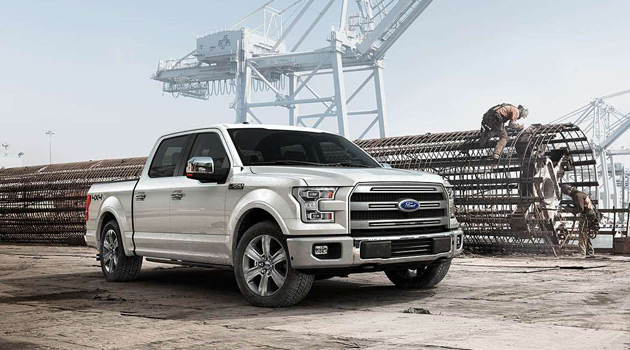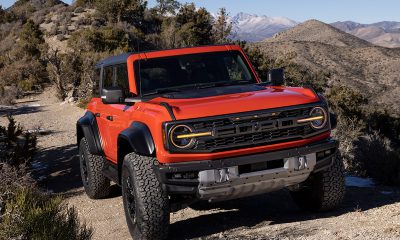Trucks
Ford F-150 Pioneers Mainstream Aluminum Design

Ford turned the truck world upside down recently with the release of its all-new aluminum-bodied F-150. By pioneering aluminum production at a massive scale, Ford blew away long-held perceptions. The top-selling truck in America is now more than a sales leader — it is a production marvel as well.
After decades of testing, Ford finally cracked the puzzle of using large-scale aluminum with the help of Alcoa, a leading aluminum producer. The lighter-weight metal’s usage is incredibly important for meeting growing consumer demand for better fuel economy and pending CAFE requirements. Ford’s breakthrough has created a “follow the leader” mentality among other makers.
Why Aluminum Matters
In order to understand why aluminum is a big deal, you first have to understand a growing issue for all automakers: how fuel efficient their products need to be.
This issue is being driven by two things:
- Consumers are demanding better fuel efficiency with rising fuel prices over the last few years.
- New Corporate Average Fuel Economy (CAFE) requirements are being phased in over the next few years. These requirements set fuel economy targets for automakers, with substantial penalties for automakers that fail to meet targets.
For truck makers, meeting these fuel economy targets is especially tricky. A truck is essentially a box on wheels and, therefore, there are limits to how aerodynamic you can make it. Also, a truck needs to still be capable of withstanding a multitude of purposes like towing, off-roading, hauling, etc., so it needs a big (and relatively inefficient) engine to do its’ job.
Enter aluminum, which is much lighter than steel. The weight savings translate into immediate fuel efficiency increases, but without any sort of sacrifice in function or capability. For example, Ford says their new truck is nearly 700 lbs. lighter than last year’s steel model. This weight loss should result in a minimum improvement of three mpg and could be more like five mpg combined city/highway.
Of course, aluminum has some downsides as well. It can be hard to repair, easier to dent, is more vulnerable to corrosion (at least when combined with steel), and is harder to build with. To their credit (and with some help from Jaguar and Land Rover), Ford has acknowledged and addressed these limitations in their new aluminum F-150.
How Ford Overcame Aluminum’s Limitations
For years, automakers like Jaguar and Land Rover have used aluminum to construct vehicle bodies, and they’ve learned an awful lot about this material. Since Ford used to own Jaguar and Land Rover – and allegedly, Ford engineers helped to develop the aluminum construction processes these companies now employ – it was logical for Ford to build an aluminum truck. However, Ford needed to make sure the F-150 was “built Ford tough,” and that meant that they couldn’t necessarily use the same grades of aluminum found in the typical Jaguar or Range Rover. Ford decided to use high-grade aluminum alloy (the same kind of alloy used in airplanes) as the primary material for the new F-150.
The aviation world has been using a high-grade aluminum alloy for years. The alloy withstands the punishment of flying through a variety of conditions for years. Ford rationalized that if it can withstand the punishment air travel puts on it, the aluminum-alloy should hold up in trucks. Plus, their CEO at the time, Alan Mulally was formerly the CEO of Boeing. He knows a thing or two about high-grade aluminum and was a big proponent of its usage.
One obstacle remained for Ford to work through. An airplane uses long pieces of aluminum that don’t require much bending. A truck uses the shorter pieces with many aerodynamics and styling bends. Aluminum, by its nature, doesn’t hold its form like steel and is harder to work with. Ford and Alcoa had to collaborate on the design of the truck to ensure the aluminum panels would stay bent and the production of the panels wasn’t taxing on Alcoa’s facilities. If the panels were too complex, the production price would skyrocket and quality would be a concern. By getting both right; Ford cracked the puzzle and pioneered aluminum’s usage on a scale previously unseen.
Ford’s New F-150 Leads the Way
Make no mistake, the fact that the industry’s top-selling truck will switch to an aluminum body is a big deal. The truck segment is one of the most competitive areas in the automotive world, and this is a big differentiator that other truck manufacturers will have to copy to keep pace. For example, immediately after Ford unveiled their new aluminum F-150, GM made plans to launch new aluminum-bodied trucks themselves by 2018. Other makers like Ram say they are ready to go aluminum if the truck market embraces the new F-150.
Simply put, this truck is going to be the “silver bullet” driving other makers to develop their own aluminum-bodied trucks in the near term.
With all the truck makers adopting aluminum, truck buyers will reap real-world fuel savings. These savings might have been realized on a small scale, yet now, thanks to Ford, consumers will get massive fuel economy improvements.
Ultimately, Ford’s pioneering efforts to bring aluminum usage to the mainstream will have a long lasting impact on the automotive market. The move will go down as one of the defining moments in automotive history and will spur everyone else to play catch up.




























Recent Comments